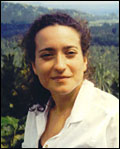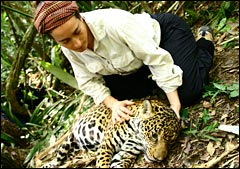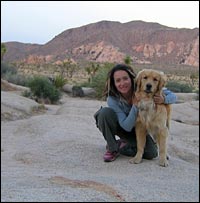
Cheri Sugal.
What work do you do?
I am the executive director of Friends of Calakmul.
What does your organization do?
Our organization protects land in the threatened rainforest of southern Mexico’s Yucatan Peninsula, in the Calakmul Biosphere Reserve. We sign lease agreements with local landowner groups, called ejidos. In exchange for an annual payment, these ejidos agree to give up their logging rights and engage in conservation activities. Communities vote to enter these agreements, and the compensation they receive is more than what they would get paid from a logging company. Plus we are helping them generate additional income through developing conservation-friendly activities on their land.
Our approach provides an alternative to creating or expanding a national park (in most of the developing world, national parks are terribly underfunded already), and allows local people to maintain ownership of their land.
What are you working on at the moment?
Last December, our organization received a $350,000 grant from Conservation International’s Global Conservation Fund, which is allowing us to expand the land that we are protecting from 200,000 acres to 350,000 acres. Just last month, we signed the first of three agreements we plan to sign this year, adding 57,000 acres to the land that is now permanently protected from logging and other development.
How do you get to work?
My commute generally involves walking from my bedroom to my home office or down the street to a local café — wherever I can get an internet connection. I travel to Mexico about every other month.
What long and winding road led you to your current position?
In 1994, I graduated from Stanford University with an M.A. in applied economics and a focus on environmental economics. In graduate school, I was fascinated by the challenges that indigenous people face in maintaining their natural and cultural heritage.
I worked as a contractor with the World Bank for a brief period, then with World Wildlife Fund, and then went to Zimbabwe to study the economic benefits of indigenous landowners diversifying their income (beyond selling hunting licenses).
Following this period, I was offered a job at Conservation International to look at the economics of large-scale logging concessions in Latin America. We found that Latin American governments, such as Guyana and Suriname, were not earning very much from providing massive logging concessions to foreign companies and that it was entirely possible for conservationists to compete for the rights to these areas. I then created a program at CI to do just that.
During that time, I worked with CI’s regional programs and partners in 25 countries setting up wilderness deals with governments and indigenous peoples. When we had deals pending on 100 million new acres (roughly the size of the state of California), we presented this portfolio to the newly created Gordon and Betty Moore Foundation, which subsequently funded what is now called the Global Conservation Fund with an initial grant of $100 million. In 2001, I became the executive director of World Parks and helped to create the Alliance for Zero Extinction to identify key sites where species were in imminent danger of disappearing. I started to focus World Parks’ efforts on protecting these highly fragmented habitats. We were an umbrella organization for several groups in Latin America, including Friends of Calakmul — where I am currently the full-time executive director.
Where were you born? Where do you live now?
I was born in New York City, spent my childhood on the Long Island Sound in Glen Cove, did my undergraduate and graduate school at Stanford, spent most of my 20s in Washington, D.C., and traveling internationally, and moved to San Francisco in 2001. I now live in the mountains, in North Lake Tahoe.
What’s been the best moment in your professional life to date?

Sugal and a jaguar.
My most recent best was participating in a jaguar capture in the Calakmul rainforest with FOC’s cofounders, donors, and the Mexican media. Our group went to see firsthand the process of tracking and radio-collaring jaguars — a methodology that allows researchers to identify the areas most significant for ensuring the survival of the jaguar population. During our visit, we tracked two jaguars in two days and had the wild luck of seeing a third walking down the road when our vehicle had broken down. Having met many researchers studying big cats who had never even seen the cats they were studying, I knew what a unique and special opportunity this was. Our hope is to eventually develop specialized trips so that others can have the experience of seeing jaguars in the wild.
What environmental offense has infuriated you the most?
The bushmeat trade in central Africa. Although bushmeat has always been an important source of protein for local people, the commercialization of the bushmeat trade, facilitated by the opening of the forest by logging companies, is driving the extinction of so many mammals in west and central Africa — not to mention bringing diseases out of the forest. It is devastating to think about, and even worse to see firsthand.
Who is your environmental hero?
Mike Fay, for his die-hard commitment to protecting the forests of central Africa. Thanks to the attention that Mike and the Wilderness Conservation Society brought to these remote areas, Gabon’s president in 2002 recognized 13 new protected areas, taking 10 percent of the country out of the hands of loggers. This was potentially the most significant conservation action since 1872 when Yellowstone National Park was created. Seeing this success gives me confidence in the power of individuals to make a difference.
What’s your environmental vice?
Driving my car.
How do you spend your free time?

Sugal and a tamer beast.
Snowboarding, rock-climbing, training in the backcountry (avalanche training, etc.), and hiking with Bodhi, my 2-year-old golden retriever.
I also serve as an adviser to the Natural World Museum, the official art exhibit for World Environment Day, and I am starting a business called the Gaia Restoration Project that will provide spiritual and skill-building retreats for women into remote locations.
Which stereotype about environmentalists most fits you?
I am a Democrat.
What’s your favorite place or ecosystem?
Although I have many favorite places around the world (like the savannas of southern Africa, the tropical forests of central Africa, the Osa Peninsula of Costa Rica, the tepuis of Venezuela, and the Selva Maya forest where I now work), I recently have fallen in love with the Eastern Sierras in my own backyard.
What’s your favorite movie?
Which actor would play you in the story of your life?
I really admire Daryl Hannah‘s commitment to and passion for the environment.
If you could have every InterActivist reader do one thing, what would it be?
Do anything that reconnects you with the natural world. Every time I am in nature, I am reminded of the interconnectedness of all things, and this keeps me working from a spiritual place.

